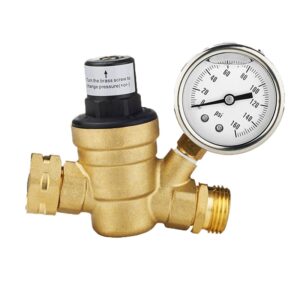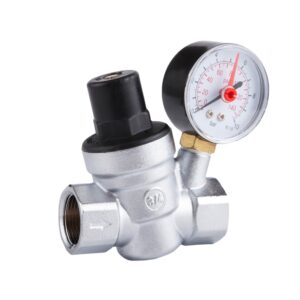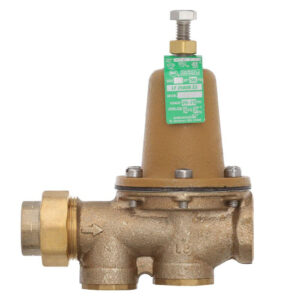Description
Brass Pressure Reducing Valve with NF certification
JX-0316
Compensated piston operation.
FXF threads.
Nickel-plated finish
Minimum and maximum working temperatures: 0°C-60°C.
Maximum inlet pressure: 16 bar.
Outlet pressure can be adjusted: 1/2” – 3/4” between 1 and 6 bar;
The pressure Range is 1-6 bar. Outlet pressure gauge connection 1/4″ on both sides.
DIN EN ISO 228 and BS EN ISO 228).

| Body | Brass | CW617N |
| Medium | Water | |
| Type | Filter/No filter | |
| Orifice | 2.5 mm | 0 to 2.5mm(adjustable) |
| Pipe size | 1/2″, 3/4″ | |
| Working pressure | 0 to 1 Mpa | |
| Working temperature | 0.1 to 60 °C | |
| Finish | Sandblasted with nickel plated | |
| Certification | NF | |
| Material of seal | Hydraulic | |
Brass Pressure Reducing Valve
Brass pressure-reducing valves are used in various plumbing, sprinkler, and irrigation systems. These valves are designed to regulate the flow of high-pressure water into lower-pressure areas. A brass pressure-reducing valve is essential to any plumbing system because it helps maintain even water pressure throughout the system.
The most common type of brass pressure-reducing valve consists of a body, spring, seat, and diaphragm. The body is made from durable brass and contains a series of internal passages that allow the water to flow through. The spring keeps the seat pressed against the diaphragm while controlling the force applied by adjusting the spring’s tension. This ensures that only a predetermined amount of water passes through at any time.
Benefits: Increased Efficiency
A brass pressure-reducing valve is an essential piece of equipment in any industrial setting. It is designed to control the flow of liquids, gases, or steam and can be used in various applications such as water distribution systems, sewage systems, and gas pipelines. Businesses can use a brass pressure-reducing valve to ensure that their machinery runs smoothly and efficiently and avoid potential problems due to overpressure.
Increased efficiency is one of the most significant benefits of using a brass pressure-reducing valve. The device allows for precise control over liquid or air flow, ensuring that operators achieve the best results with minimal effort. This increases efficiency and reduces costs associated with energy consumption or maintenance expenses that may arise from too much or too little pressure going through your system.
Features: Durability, Variety of Sizes
A brass pressure-reducing valve is vital in any home, business, or industrial setting. It is designed to reduce the pressure applied to specific systems, so they don’t exceed the maximum safe levels. This type of valve offers users durability and a variety of sizes to meet their needs.
The most important feature of these valves is their ability to maintain a consistent pressure level regardless of changes in external conditions. The brass material in their construction makes them exceptionally resistant to corrosion and wear over time. They will keep working for extended periods without developing leaks or other damages. Furthermore, brass has excellent heat-conducting properties, which help it perform more efficiently than other materials commonly used for this purpose.
Installation Process: Easy to Install
The Brass Pressure Reducing Valve is one of the market’s most efficient and reliable valves. This product ensures that water pressure is kept within a safe range, protecting your home from the risks associated with high-pressure systems. Installing this valve couldn’t be easier – follow these simple steps to get your system up and running in no time!
Firstly, you’ll need to determine the exact location for installation. It is essential to choose a spot where it won’t interfere with any existing plumbing fixtures or valves. Next, attach the valve by connecting copper tubing or a flexible hose directly to its ports. Make sure to use thread sealant tape when tightening threaded connections. Once attached, slowly open each port valve until they are fully open, and test for leaks using soapy water if necessary.
Maintenance Tips: Regular Inspections
Regular inspections of a brass pressure-reducing valve are important for ensuring safe and efficient operation. Checks should be done at least once per year, or more, depending on the specifics of the application. Regular inspections will help to identify any signs of wear or damage that may occur from use over time, allowing for necessary repairs before system failure can occur.
To inspect a brass pressure-reducing valve, shutdown and isolation must be used to ensure safety. This involves disconnecting power sources and shutting off water supplies if applicable. Once the valve is isolated, check for any visual signs of damage, such as leaks or corrosion, and check all connections for proper tightness. Additionally, check for loose parts that might need to be tightened or replaced during maintenance.
Conclusion: Ideal Solution for Pressure Regulation
The ideal solution for pressure regulation is the brass pressure-reducing valve. This type of valve has been proven reliable, dependable, and efficient in regulating the pressure of gases and liquids that flow through it. The brass material used to make this type of valve provides superior corrosion resistance, ensuring its longevity and reliability. The construction of the valves ensures a smooth flow with no abrupt changes in direction or turbulence, which can lead to inefficient operation and energy loss.
The brass pressure-reducing valve also features an adjustable spring mechanism that allows for easy pressure adjustment based on the requirements of different systems. This feature also ensures accurate control over the rate at which liquid flows through it, allowing for optimum performance at all times. Additionally, these valves are available in a wide variety of sizes, making them suitable for any application regardless of size or complexity.







